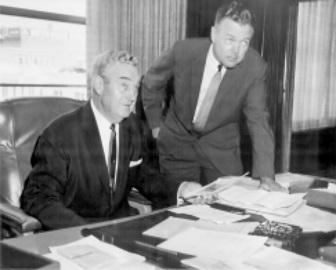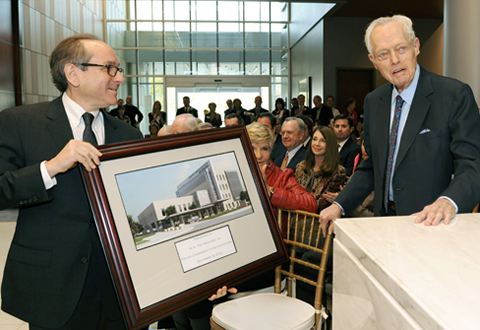Moncrief makes East Texas History
Wildcatter who confounded geologists in 1931 and launched lengthy career as independent producer.
When a Fort Worth independent producer completed a remote wildcat well in East Texas on January 26,1931, the well revealed the true extent of an oilfield discovered months earlier and many miles away.
As the Great Depression worsened and East Texas farmers struggled to survive, W.A. “Monty” Moncrief and two partners drilled the Lathrop No. 1 well in Gregg County. When completed in 1931, their well produced 320 barrels of oil per hour from a depth of 3,587 feet.
Far from what earlier were thought to be two oilfield discoveries — this third well producing 7,680 barrels a day revealed a “Black Giant.”

A circa 1960 photograph of W.A. “Monty” Moncrief and his son “Tex” in Fort Worth’s Moncrief Building.
Moncrief, who had worked for Marland Oil Company in Fort Worth after returning from World War I, drilled in an region (and a depth) where few geologists thought petroleum production a possibility. He and fellow independent operators John Ferrell and Eddie Showers thought otherwise.
The third East Texas well was completed 25 miles north of Rusk County’s already famous October 1930 Daisy Bradford No. 3 well drilled by Columbus Marion “Dad” Joiner northwest of Henderson (and southeast New London, site of a tragic 1937 school explosion).
Moncrief’s oil discovery came 15 miles north of the Lou Della Crim No. 1 well, drilled three days after Christmas, on “Mama” Crim’s farm about nine miles from the Joiner well. At first, the distances between these “wildcat” discoveries convinced geologists, petroleum engineers (and experts at the large oil companies) the wells were small, separate oilfields. They were wrong.
Three Wells, One Giant Oilfield
To the delight of other independent producers and many small, struggling farmers, Moncrief’s Lathrop discovery showed that the three wells were part of a single petroleum-producing field. Further development and a forest of steel derricks revealed the northernmost extension of the 130,000-acre East Texas oilfield.
The history of the petroleum industry’s gigantic oilfield has been preserved at the East Texas Oil Museum, which opened at Kilgore College in 1980. Joe White, the museum’s founding director, created exhibit spaces for the “authentic recreation of the oil discoveries and production in the early 1930s in the largest oilfield inside U.S. boundaries.”
After more than half a century of major discoveries, William Alvin “Monty” Moncrief died in 1986. His legacy has extended beyond his good fortune in East Texas.
The family exploration business established by Moncrief in 1929 would be led by sons W.A. “Tex” Moncrief Jr. and C.B. “Charlie” Moncrief, who grew up in the exploration business. In 2010, Forbes reported that 94-year-old “Tex” made “perhaps the biggest find of his life” by discovering an offshore field of about six trillion cubic feet of gas.
Moncrief Philanthropy
Hospitals in communities near the senior Moncrief’s nationwide discoveries, including a giant oilfield in Jay, Florida, revealed in 1970, and another in Louisiana, have benefited from his drilling acumen.
Moncrief and his wife established the William A. and Elizabeth B. Moncrief Foundation and the Moncrief Radiation Center in Fort Worth, as well as the Moncrief Annex of the All Saints Hospital. Buildings in their honor have been erected at Texas Christian University, All Saints School, and Fort Worth Country Day School.

Dr. Daniel Podolsky in 2013 presented W.A. “Tex” Moncrief Jr. with a framed image of the new Moncrief Cancer Institute at the Fort Worth facility’s dedication ceremony.
Supported throughout the 1960s and 1970s by the Moncrief family, Fort Worth’s original Cancer Center, known as the Radiation Center, was founded in 1958 as one of the nation’s first community radiation facilities.
In 2013, the $22 million Moncrief Cancer Institute was dedicated during a ceremony attended by “Tex” Moncrief Jr. “One man’s vision for a place that would make life better for cancer survivors is now a reality in Fort Worth,” noted one reporter at the dedication of the 3.4-acre facility at 400 W. Magnolia Avenue.

Small investments from hopeful Texas farmers will bring historic results — and make Kilgore, Longview and Tyler boom towns during the Great Depression. Kilgore today celebrates its petroleum heritage.
Early Days in Oklahoma
Born in Sulphur Springs, Texas, on August 25, 1895, Moncrief grew up in Checotah, Oklahoma, where his family moved when he was five. Checotah was the town where Moncrief attended high school, taking typing and shorthand — and excelling to the point that he became a court reporter in Eufaula, Oklahoma.
To get an education, Moncrief saved $150 to enroll at the University of Oklahoma at Norman, where he worked in the registrar’s office. He became “Monty” after his initiation into the Sigma Chi fraternity.
During World War I, Moncrief volunteered and joined the U.S. Cavalry. He was sent to officer training camp in Little Rock, Arkansas, where he met, and six months later married, Mary Elizabeth Bright on May 28, 1918. Sent to France, Moncrief saw no combat thanks to the Armistice being signed before his battalion reached the front.
After the war, Moncrief returned to Oklahoma where he found work at Marland Oil, first in its accounting department and later in its land office. When Marland opened offices in Fort Worth in the late 1920s, Moncrief was promoted to vice president for the new division.
In 1929, Moncrief would strike out on his own as an independent operator. He teamed up with John Ferrell and Eddie Showers, and they bought leases where they ultimately drilled the successful F.K. Lathrop No. 1 well.
C.M. “Dad” Joiner’s partner, the 300-pound self-taught geologist A.D. “Doc” Lloyd, had predicted the field would be four to ten miles wide and 50 to 50 miles long, according to Moncrief, interviewed in 1985 for Wildcatter: A Story of Texas Oil.
“Of course, everyone at the time thought he was nuts, including me,” the Texas wildcatter added. Also interviewed, museum founder Joe White said Lloyd’s assessment predicted the Woodbine sands at a depth of 3,550 — about two thousand of feet shallower than major oil company geologists believed.
Moncrief’s Lathrop January 1931 wildcat well, which produced from the Woodbine formation at a depth of 3,587 feet, proved the oilfield stretched 42 miles long and up to eight miles wide — the largest in the lower-48 states.
_______________________
Recommended Reading: The Black Giant: A History of the East Texas Oil Field and Oil Industry Skulduggery & Trivia (2003); Early Texas Oil: A Photographic History, 1866-1936
(2000). Your Amazon purchase benefits the American Oil & Gas Historical Society. As an Amazon Associate, AOGHS earns a commission from qualifying purchases.
_______________________
The American Oil & Gas Historical Society (AOGHS) preserves U.S. petroleum history. Please become an AOGHS supporter and help maintain this energy education website and expand historical research. For more information, contact bawells@aoghs.org. Copyright © 2025 Bruce A. Wells. All rights reserved.
Citation Information – Article Title: “Moncrief makes East Texas History.” Authors: B.A. and K.L. Wells. Website Name: American Oil & Gas Historical Society. URL: https://aoghs.org/petroleum-pioneers/moncrief-oil. Last Updated: January 17, 2025. Original Published Date: January 25, 2015.




